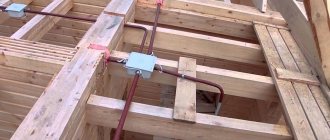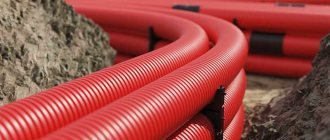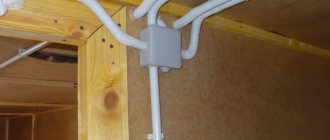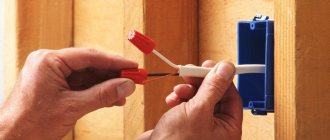Rules and features of choosing the type of cable fastener
Fasteners for the cable are selected depending on the method of laying it and the base material to which the wire will be fixed. Let's start with choosing the material.
The cable fastening is selected depending on the type of laying (open or closed) and the type of base
Depending on the type of material
All bases are divided into soft and hard, but there are also thin and brittle ones. Soft bases include wood, and plaster can also be included here. If you need to attach the cable to these bases, nails or self-tapping screws are most often used. The process of installing fasteners is known to everyone and does not take much time.
Cable fastening is mostly done using dowels
Rigid foundations include concrete, reinforced concrete, and brick. Fasteners with dowels (dowel-nails) are installed in such bases. The process of installing a dowel is longer - you first have to drill holes and insert a plastic plug, only then install the fasteners. But in such materials this is inevitable. The exception is brickwork. If you place fasteners in a seam, you can use nails. But the fastening in this case will not be very reliable.
Brittle bases. This category includes plasterboard and building blocks made of lightweight cellular concrete of any type. For these bases there are special dowels that have a larger support area than standard ones. There are also glue-based fasteners for lightweight cellular concrete.
Special butterfly dowels for installation in drywall or foam concrete
Thin bases. These are plastic, fiberboard, chipboard and other similar materials. If you need to secure the cable on such a surface, use thin nails and staples; if there are a small number of conductors, use adhesive-based fasteners. Usually these are small plastic elements with adhesive tape with a protective strip attached to the back side. During installation, the protective strip is removed and the fasteners are installed with glue. It will not withstand heavy loads, but you can organize the wiring harness that goes to the desktop.
Nails, screws or dowels?
Most standard fasteners can be fixed either with nails or self-tapping screws, or with dowels. In accordance with the type of material, its strength and density, choose the type of fastening elements.
Dowels are most often used
There are a few exceptions. For example, U-shaped staples from a construction stapler can only be installed in soft substrates or chipboard, and dowel clips are not suitable for them.
Installation rules
Regardless of the type of fastener chosen, it is worth following simple rules for its location. In this case, the cable fastening will be secure.
- The optimal distance between two elements is 40-50 cm.
- In places of rotation, place the fasteners 5-10 cm from the bend.
- The heads of nails, dowels, and screws should not stick out, otherwise they may damage the cable insulation.
- The cable should not sag, the tension should be uniform. If a supply is needed, it is rolled into a ring and placed in one place.
Installing cable clamps
These are all general rules for attaching cables. This is not a dogma, but their implementation makes the work easier and guarantees normal results.
Surface-mounted fasteners
To fix the cable when installing open wiring, use:
- cable channels;
- insulators;
- nail staples.
Cable channels
A cable duct is a plastic box in which electrical wires are located. Channels come in different sizes, which allows you to lay both one cable and several wires at the same time.
Devices for open wiring
The advantages of plastic channels for electrical cables are:
- appearance that allows you to keep the design of the room tidy;
- the ability to install anywhere (under the ceiling, above the baseboard, above the window, behind furniture, and so on);
- low cost;
- ease of installation.
To secure wiring using cable ducts, you must:
- Mark the installation area for the plastic cable box. To do this, the location of the device fixation is determined on the wall (ceiling) and the horizontal position of the channel is checked;
- in certain places, holes are drilled for fastening the box;
- if cable channels are installed in stone, brick or concrete houses, then a dowel is inserted into each hole. When installing channels in wooden houses, this step is skipped;
- the cable box is fixed;
Fixing the cable channel on the wall
- electrical wires are laid in the channel;
Placing wires in a cable channel
- The box is closed with a lid, which is equipped with special latches for secure fixation.
The selection criteria and installation of the cable channel are discussed in detail in the video.
Insulators
To fix the wiring in a bathhouse or wooden house, special insulators are used. Small devices made of porcelain are equipped with a mounting bolt.
Device for fixing electrical cables
Simplicity of installation and low cost determine the widespread use of the fastening element when arranging open wiring.
Installation is done like this:
- the insulator is fixed to the wall using a self-tapping screw;
- the twisted wire is placed over the notch at the top of the cup.
Fixing the wire with an insulator
Nail staples
Vultures and other types of wires for distributing electricity can be secured using nail clips.
Cable fastening for open wiring
The fastening device is easy to install (the bracket with cable is fixed to the wall, floor or ceiling) and has a pleasant appearance.
When selecting nail staples, it is necessary to take into account the diameter of the wire that needs to be secured.
Having familiarized yourself with the most popular methods of cable fastening, you can easily choose the most suitable option both in appearance and in cost.
How to secure cables to the ceiling
If there are not very many cables on the ceiling, you can use ordinary fasteners - clamps, ties, clips, homemade clamps, etc. But they are inconvenient to install - you have to work for a long time with your hands raised, and even hold the tool and cable in them. Hard work.
If the ceiling is suspended, the cables can be secured to hangers. In this case, use ordinary plastic clamps (tightenings), which secure the wires above the level of the future ceiling. In order not to damage the sheath or even the cores, it is better to lay the wires in a protective corrugated hose. This will also make the wiring safer from a fire safety point of view.
Wiring arrangement when installing a suspended ceiling
Large bundles of cables on the ceiling are easier to lay in trays. They are available in wire and metal (solid metal and perforated). In apartments and houses, wire ones are usually used. They cost and weigh less. They are attached to the ceiling with adjustable hangers.
Trays for laying large bundles of cables
This type of cable fastening also requires the installation of hangers, but the number of fasteners is much less. Another advantage of this method of laying cables is that it is easy to replace or lay new ones if necessary. The downside is that the trays are not very cheap.
Input of electricity into the building
As mentioned above, laying the input cable is the prerogative of the employees of the energy sales organization.
Connecting a house to a power line can be done in three ways:
- Overhead line from pole to building. Aluminum wires without insulation are used. The method is unsafe; in recent years, they have been trying not to use it.
- Input from the overhead line using SIP. Due to the reliability of the line and operational safety, this method of delivering electricity is considered a priority.
- Armored underground cable. The method is considered the safest (especially for wooden buildings), but its disadvantage is its high cost. Rarely used.
Despite the advantages of SIP described above, there are many opponents of this technology when it comes to residential buildings (even if they are houses made of brick or stone). Many experts consider the SIP insulation layer to be not reliable enough for residential buildings.
To prevent undesirable consequences in the event of an insulation rupture, cables must be positioned at a certain distance from building structures.
The fact is that overhead lines are protected from short circuits by an automatic device that operates under conditions of high currents, and shutdown, if necessary, occurs with some delay. Even in a short period of time, the resulting electric arc can ignite building structures, especially if they are wooden.
However, most specialists prefer SIP. The numerous advantages of this type of cable cancel out the disadvantages, especially since safety can be ensured using a special thick-walled metal pipe into which the cable is laid.
The pipe allows you to neutralize the effects of an electric arc
It is recommended to pay close attention to the inlet and outlet holes of the pipe: they should be covered with corrugated material to prevent the wire from chafing on the metal
One of the ways to organize the input is to switch from aluminum SIP cores to an internal cable, which is used for wiring throughout the building. The main requirement for such a cable is fire resistance. In addition, the area up to the switchboard must be additionally protected with a circuit breaker. An automatic device is all the more necessary if wires without insulation are used, connected to a piece of cable.
Note! The rating of the machine must be one value higher than the value of the input panel
How to organize bundles of wires
More and more equipment is appearing in our homes, and it all has wires. There are often about a dozen wires running to the desktop. To prevent them from getting confused, it is better to organize them. There are different types of plastic platforms for this. Some collect wires into bundles, while others, on the contrary, allow each thread to be routed separately.
Cable holder for organizing wires
Some of this cable fastening goes with self-tapping screws or nails, and some is based on Velcro. The second option can be safely installed on furniture. The adhesive adheres well to a laminated or varnished surface and there is no need to make holes.
Attaching to poles and walls using aerial installation method
When laying cables aerially, they must be secured to poles, walls of buildings and other objects. There are fasteners for self-supporting and conventional cables. Ordinary cables cannot be suspended between poles without support - they will not withstand the load and will break. For such conductors, a cable is stretched between the supports and the cable is attached to it on hangers. In this case, the load falls on the cable, and not on the cable. There are any ways to attach a cable, but the most common is to make a loop around a pole and secure the end. For intermediate posts, you can use any available method - two separate cables, a driven hook, a suitable bracket.
Attaching the cable to the poles
The cable is fastened to the supporting cable using supporting clamps. They come in cables of different shapes and cross-sections. It is also possible to use ties made of UV-resistant plastic. Sometimes, to save money, the cable is screwed in with pieces of wire, twisting it. This method is the least reliable - under heavy loads, the twist may not hold the wire, it will sag and break.
How to hang a cable from a rope
For self-supporting cables, the fastening usually consists of two parts - brackets or clamps that are attached to the wall or pole, and clamps that cling to the installed bracket and hold the cables. Clamps are used only on poles. They are especially convenient on reinforced concrete pillars - there is no need to drill holes, which is very difficult.
Several options for attaching the cable to the pole
There are several types of brackets. They are selected depending on the type of base (wooden, steel, concrete, aluminum) and the planned load. By purpose there are:
- branch - for installation on poles and supports in places where the route turns;
- intermediate fastenings - for installation on poles and supports along the route without turns or branches;
- facade - for installation on external walls.
Suspensions or clamps are attached to the brackets. They are selected depending on the type of cable, its cross-section, etc.
Cases of justified use of corrugation
In places where the wiring may be subject to mechanical damage, the cable is installed in a corrugated pipe.
It is used practically without restrictions in low-current systems:
- in signaling,
- in cable television,
- in telephone lines,
- on the Internet.
You should not do without corrugation when laying cables in a floor screed.
If the supply lines are placed under plasterboard or suspended ceilings, then it is more convenient to use a corrugated pipe. Then the wiring changeability requirement given in Chapter 7.1 will be met. clause 7.1.37. PUE, and additional mechanical protection of the power line will be provided.











